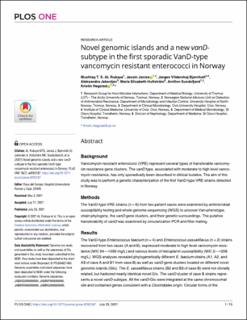| dc.contributor.author | Al-Rubaye, Mushtaq | |
| dc.contributor.author | Janice, Jessin | |
| dc.contributor.author | Bjørnholt, Jørgen Vildershøj | |
| dc.contributor.author | Jakovljev, Aleksandra | |
| dc.contributor.author | Hultström, Maria Elisabeth | |
| dc.contributor.author | Sundsfjord, Arnfinn | |
| dc.contributor.author | Hegstad, Kristin | |
| dc.date.accessioned | 2023-01-06T13:25:01Z | |
| dc.date.available | 2023-01-06T13:25:01Z | |
| dc.date.created | 2021-08-05T15:03:46Z | |
| dc.date.issued | 2021 | |
| dc.identifier.citation | PLOS ONE. 2021, 16 (7), 1-15. | en_US |
| dc.identifier.issn | 1932-6203 | |
| dc.identifier.uri | https://hdl.handle.net/11250/3041627 | |
| dc.description.abstract | Background - Vancomycin-resistant enterococci (VRE) represent several types of transferable vancomycin resistance gene clusters. The vanD type, associated with moderate to high level vancomycin resistance, has only sporadically been described in clinical isolates. The aim of this study was to perform a genetic characterization of the first VanD-type VRE strains detected in Norway.
Methods - The VanD-type VRE-strains (n = 6) from two patient cases were examined by antimicrobial susceptibility testing and whole genome sequencing (WGS) to uncover Van-phenotype, strain phylogeny, the vanD gene clusters, and their genetic surroundings. The putative transferability of vanD was examined by circularization PCR and filter mating.
Results - The VanD-type Enterococcus faecium (n = 4) and Enterococcus casseliflavus (n = 2) strains recovered from two cases (A and B), expressed moderate to high level vancomycin resistance (MIC 64—>256 mg/L) and various levels of teicoplanin susceptibility (MIC 2—>256 mg/L). WGS analyses revealed phylogenetically different E. faecium strains (A1, A2, and A3 of case A and B1 from case B) as well as vanD gene clusters located on different novel genomic islands (GIs). The E. casseliflavus strains (B2 and B3 of case B) were not clonally related, but harbored nearly identical novel GIs. The vanD cluster of case B strains represents a novel vanD-subtype. All the vanD-GIs were integrated at the same chromosomal site and contained genes consistent with a Clostridiales origin. Circular forms of the vanD-GIs were detected in all strains except B1. Transfer of vanD to an E. faecium recipient was unsuccessful.
Conclusions - We describe the first VanD-type E. casseliflavus strains, a novel vanD-subtype, and three novel vanD-GIs with a genetic content consistent with a Clostridiales order origin. Despite temporal occurrence, case A and B E. faecium strains were phylogenetically diverse and harbored different vanD subtypes and vanD-GIs. | en_US |
| dc.language.iso | eng | en_US |
| dc.publisher | Public Library of Science | en_US |
| dc.rights | Navngivelse 4.0 Internasjonal | * |
| dc.rights.uri | http://creativecommons.org/licenses/by/4.0/deed.no | * |
| dc.title | Novel genomic islands and a new vanD-subtype in the first sporadic VanD-type vancomycin resistant enterococci in Norway | en_US |
| dc.type | Peer reviewed | en_US |
| dc.type | Journal article | en_US |
| dc.description.version | publishedVersion | en_US |
| dc.source.pagenumber | 1-15 | en_US |
| dc.source.volume | 16 | en_US |
| dc.source.journal | PLOS ONE | en_US |
| dc.source.issue | 7 | en_US |
| dc.identifier.doi | 10.1371/journal.pone.0255187 | |
| dc.identifier.cristin | 1924187 | |
| cristin.ispublished | true | |
| cristin.fulltext | original | |
| cristin.qualitycode | 1 | |

